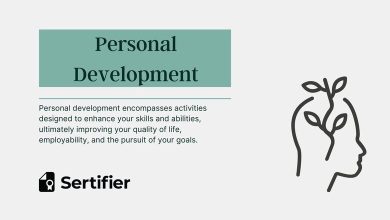Table of Contents
Introduction
In today’s rapidly changing business landscape, organizations realize the importance of investing in their most valuable asset – their employees. Employee development programs have emerged as a strategic approach to fostering growth, engagement, and success within modern workplaces. In the dynamic landscape of the modern workplace, the mantra for success is clear: invest in the growth and development of your employees.
Employee development programs, often referred to as professional development or training programs, have emerged as a cornerstone for fostering both individual and organizational growth.
This blog piece aims to explore the various aspects of employee development programs, delve into the benefits they offer for individuals and organizations such as the microcredentials they offer, discuss key considerations in designing effective programs, highlight the role of technology, particularly Learning Management Systems (LMS), and underscore the significance and potential of investing in employee development as a catalyst for sustained organizational growth.

By the time you finish reading, you will comprehend why employee development programs are not just a business strategy but a transformative force that propels your organization to new heights.
The Importance of Employee Development Programs

Employee development programs are, without a doubt, a critical element in the success of any organization. These programs, designed to enhance the knowledge, skills, and abilities of employees, have a profound impact on individual growth and the organization as a whole. Moreover, employee development programs cultivate a culture of continuous learning and improvement, leading to higher job satisfaction, increased employee retention rates, and improved overall performance. Let’s delve into the reasons why employee development programs are of paramount importance:
Enhanced Employee Performance
Employee development programs provide structured training and customized development initiatives that empower employees to acquire new skills and competencies necessary for meeting evolving job demands. This enables employees to take on new challenges and responsibilities, leading to personal and professional growth.
Investing in your employees’ development leads to a significant boost in their performance. As they acquire new skills and knowledge, they become better equipped to excel in their roles, which ultimately translates into increased productivity and better results.
Increased Employee Engagement
Employee development programs foster a sense of purpose and motivation among employees. As employees witness the organization’s commitment to their growth and well-being, they become more engaged in their work, resulting in higher productivity levels and improved job satisfaction. Hence, employee engagement is a pivotal factor in the
workplace’s success. When employees feel that their growth is supported and encouraged, they are more likely to be engaged and committed to their work, which in turn leads to lower turnover rates.
Talent Retention
Attracting top talent is a challenge for any organization but retaining them can be even more daunting. Employee development programs demonstrate your commitment to your employee’s growth and development, making it more likely for them to stay and contribute to the organization’s long-term success. In addition, organizations that prioritize employee development are more likely to retain their top talent. When employees feel valued and see a clear path for growth within the organization, they are less likely to seek external opportunities.
Adaptation to Change
In today’s fast-paced business environment, change is constant. Employee development programs help your workforce adapt to new technologies, processes, and industry trends, ensuring your organization remains competitive in a rapidly evolving world.
Organizational Excellence
As employees grow and acquire new skills, organizations benefit from a more skilled and capable workforce. This translates into improved operational efficiency, increased innovation, and a competitive advantage in the market.
Innovation and Creativity
Continuous learning and exposure to new ideas can fuel innovation and creativity. Employees who participate in development programs are more likely to generate innovative solutions and contribute to your organization’s growth.
Employee Development Programs: Benefits for Individuals and Organizations

The advantages of employee development programs are profound and far-reaching, impacting both the individual employees and the organizations they serve. Let’s explore these benefits in detail:
For Individuals
1. Skill Enhancement
Employee development programs offer individuals the opportunity to acquire new skills, making them more valuable in the job market. These new skills can also lead to career advancement and higher earning potential.
2. Increased Job Satisfaction
Employees who feel that their employer cares about their personal and professional growth are often more satisfied in their roles. Job satisfaction can lead to better mental health and overall well-being.
3. Career Advancement
A well-structured employee development program can provide a clear path for career advancement, helping employees set goals and work towards achieving them.
4. Higher Self-Esteem
As individuals achieve milestones and acquire new skills, their self-esteem and self-confidence naturally grow, positively impacting both their personal and professional lives.
5. Lifelong Learning
Employee development programs encourage lifelong learning, instilling a growth mindset in individuals. This attitude of continuous improvement is not only beneficial for their careers but also for their personal development.
For Organizations:
1. Increased Productivity
Employees who participate in development programs tend to be more productive and efficient in their roles, directly benefiting the organization’s bottom line.
2. Talent Development
Investing in employee development is an investment in your organization’s future leadership. The individuals who receive training today may become the leaders of tomorrow.
3. Competitive Advantage
Organizations that prioritize employee development are better equipped to adapt to change and seize new opportunities, giving them a competitive advantage in the market.
4. Improved Organizational Culture
Employee development programs contribute to a positive organizational culture by fostering a learning environment, promoting open communication, and showing a commitment to employee growth.
5. Reduced Turnover
High employee turnover is costly and disruptive. Employee development programs can significantly reduce turnover rates by keeping employees engaged and satisfied in their roles.
The Role of Corporate Academies on Employee Skill Development
Images of monotonous training sessions and hours of video may come to mind when you think of a Corporate Academy. But this does not have to be the scenario! Corporate academies have changed over time. They’re now more than just a hours of mandated video lectures. And they’re more significant and effective than ever. Corporate Academies can have a tremendous influence on employee productivity and retention while also adding value to an organization’s culture. Many employees enjoy the thought of learning in a college-like environment without leaving the office. For this reason, you will learn about employee skill development in this content.
What Is a Corporate Academy?
A corporate academy is an educational institution that operates within a company. It offers learning and development activities that are suited to the corporation’s employees’ interests and needs.
This includes providing company-specific management training and leadership development in order to sustain corporate competitiveness in ever-changing markets.
Corporate academies can be online or have real facilities like an academy campus; in fact, corporate academies can collaborate with higher education institutions to provide increased learning opportunities. Enrolling in a corporate academy allows employees to gain professional certificates and skill badges at various levels.
Beyond everything, a corporate academy is a corporate strategic instrument for achieving its business objectives. But first, let’s talk about the value they provide to enterprises.

Why Are Corporate Academies Important?
Businesses hope that their employees arrive prepared to do their jobs, right? However, what they learnt at regular academic institutions may not be sufficient. Higher education programs do not always adequately equip students for the real world of a high-level corporation.
It is just not possible to replicate an organization’s culture and surroundings as if you were already a member of its workforce. Corporate academies have a precision that no academic institution will ever have.
Additionally, many employees join a company desiring to learn to advance in their careers. Why waste all that potential and drive? Corporate academies also address employee skill development and learning needs. At the end of the day, a corporate Academy wants to develop individuals that are prepared, educated, and confident. Corporate academies serve as a breeding ground for talented employees.
A leading corporate academy demonstrates how benefiting people individually improves the overall firm. Let’s talk about the advantages of an effective corporate academy for businesses and their staff.

The Key Benefits of a Corporate Academy
Obtaining executive support for the establishment of a Corporate Academy might be difficult at times. It’s especially difficult if your company currently outsources training programs. Make sure to emphasize the benefits to both the corporation and the personnel, as these benefits frequently overlap.
Five Key Benefits Of Corporate Academies
Here are some of the ways a corporate Academy might benefit a firm and its employees:
- Supports Leader Retention and Strengthens Culture. Keeping leaders in-house is a challenge that practically all developing businesses encounter. A corporate academy allows students to advance to positions of leadership. The institution also conveys the organization’s commitment to developing leaders and elevating them from within. Although a firm may be a wonderful place to work, onboarding and other training activities frequently do not reflect the culture. A corporate academy helps employees understand and embrace the company’s identity and culture.
- Gives Users Complete Control Over How They Interact with Content. Everyone has a different learning style; some people learn better through videos, while others prefer eLearning updates delivered to their phone. Because a corporate academy is not contracted, you may select the optimal content delivery options for your learners.
- Knowledge Exchange. This training is driven by experienced staff. These improve organizational employee skill and generate backups for all jobs and processes. These could be technical or non-technical courses. This also assists in ensuring a seamless delivery and accurately setting expectations. This is an intangible advantage.
- Improve Employee Skill. These trainings are driven by already competent professionals. These improve the organizations’ capacities. These could be technical or non-technical skill development. These support firms in motivating employees to add value by enhancing processes and systems. Employees are also encouraged to think outside the box to bring more value.
- Increase the Organization’s Skills and Capabilities. When a business wishes to introduce a new ability that does not currently exist within the organization, it hires external trainers to train existing personnel. These are required for new businesses and projects that produce new revenue. With the current trend of rapidly changing technologies and approaches to driving business, every firm must keep up. That may be necessary at times to survive the competition.

A Corporate Academy Cultivates Talent, Loyalty, And Leadership
To build a case study-worthy corporate academy, your organization does not require a spectacular campus or a well-known brand name.
Keep in mind that education is an investment. If you invest in your employees’ futures, they will feel nurtured and loyal to your company.
Corporate academies of today do not have to be like yesterday’s dull corporate training programs. They can concentrate on the individual benefits of continuous education rather than the company’s most pressing concerns.
The corporate academy approach enables the creation of a curriculum that feeds the employee skill that currently exist in your organization. Traditional organizations are distinguished from high-level learning organizations by their commitment to talent and leadership development.
Designing Effective Employee Development Programs: Key Considerations

Creating and implementing an effective employee development program is no small feat. It requires careful planning and consideration. Here are the key steps and considerations for designing a program that truly delivers results:
1. Identify Learning Needs
Start by identifying the skills and knowledge gaps within your organization. Conduct surveys, assessments, and performance evaluations to determine where development is needed.
2. Needs Assessment
Conducting a thorough needs assessment is crucial to identify the specific skills and competencies required within the organization. This information serves as a foundation for designing targeted employee development programs.
3. Set Clear Objectives
Define clear and measurable objectives for the program. What do you want participants to achieve? Setting specific goals will help you track progress and success.
4. Tailor Programs to Individual Needs
Not all employees have the same development needs. Offer a variety of learning opportunities and allow individuals to choose the programs that align with their career goals.
5. Provide Quality Content
Recognizing that employees have diverse learning needs and preferences is essential. Invest in high-quality resources by offering a variety of development opportunities, such as workshops, mentoring, on-the-job training, and online courses, ensures employees can choose the most suitable learning method for their growth.
6. Engage Participants
Engagement is key to the success of any development program. Use interactive, hands-on activities, and encourage group discussions and collaboration.
7. Measure and Evaluate
Implement a system to measure and evaluate the impact of the program. Use data to assess the effectiveness and make necessary adjustments.
8. Continuous Improvement
A successful employee development program is not static, these programs must align with the organization’s strategic objectives. Linking individual development plans to overall business goals ensures effective utilization of resources. It should continuously evolve to meet changing needs and align with the organization’s goals.
Career Development Plans: Empowering Employees to Reach Their Full Potential

Career development plans play a vital role in employee engagement and retention. These plans outline clear pathways for employees to advance within the organization. By fostering a culture of internal promotion and providing support for skill development, organizations encourage loyalty and dedication from their employees.
Moreover, an essential aspect of employee development is the creation of individualized career development plans. These plans provide a roadmap for employees to reach their full potential within the organization. Here’s how to empower your employees through career development plans:
1. Goal Setting
Work with employees to set clear, achievable goals that align with their skills and interests. These goals should contribute to both personal and organizational growth.
2. Skills Assessment
Identify the skills and competencies necessary for employees to reach their goals. This assessment can help determine which development programs are most relevant.
3. Learning Path
Create a learning path that includes a variety of development opportunities, such as courses, workshops, mentoring, and on-the-job training.
4. Progress Tracking
Establish a system for tracking progress and providing feedback. Regular check-ins and assessments ensure employees stay on the right track.
5. Promotion Opportunities
Clearly define the criteria and pathways for career advancement within your organization. Provide guidance on how employees can position themselves for promotions.
6. Personal Growth
Encourage employees to focus not only on their professional development but also on personal growth. Well-rounded individuals make for more valuable and engaged employees.
The Role of Technology: Learning Management Systems (LMS) in Employee Development

In the digital age, technology plays a crucial role in enabling effective employee development programs. Learning Management Systems (LMS) provide a centralized platform for organizing, delivering, and tracking employee training and development initiatives. LMS platforms offer a range of features, including course creation, progress tracking, and personalized learning paths, making it easier for organizations to facilitate employee growth at scale. Here’s how LMS technology is transforming the landscape of employee development:
1. Accessibility
LMS platforms provide a centralized hub where employees can access training materials and resources from anywhere, at any time. This accessibility is particularly beneficial for remote and global teams.
2. Personalization
LMS platforms allow for the personalization of training materials based on individual needs and progress. This tailoring ensures that employees receive the most relevant content.
3. Progress Tracking
LMS platforms enable the tracking of individual and group progress, making it easy to monitor the effectiveness of the development programs and make adjustments as needed.
4. Content Management
LMS platforms allow for the easy management and updating of training materials, ensuring that employees have access to the most current and relevant content.
5. Skill Validation with Online Badges
Online badges have become an essential component of LMS technology, allowing organizations to validate and recognize employees’ skills and accomplishments. These badges serve as a digital representation of the skills an individual has acquired and can be shared on platforms like LinkedIn, making them a valuable tool for professional networking and career advancement.
6. Collaboration and Social Learning
LMS platforms often include social and collaborative features, enabling employees to share knowledge, collaborate on projects, and learn from their peers.
7. Analytics and Reporting
LMS technology provides robust analytics and reporting tools that help organizations track the return on investment of their development programs and identify areas for improvement.
Conclusion
In the contemporary business landscape, employee development programs are not just optional, they are an absolute necessity. They are a pivotal element in building a skilled, engaged, and adaptable workforce. The benefits, both for individuals and organizations, are indisputable and substantial. By investing in the growth of your employees, you are investing in the growth of your organization.
Remember, designing effective employee development programs requires a strategic approach. It involves identifying learning needs, setting clear objectives, providing quality content, engaging participants, and continuously measuring and improving the programs. Additionally, individualized career development plans empower employees to reach their full potential and contribute significantly to the organization’s success.
Leveraging technology, such as Learning Management Systems, further enhances the effectiveness of employee development programs. These platforms provide accessibility, personalization, progress tracking, content management, and the crucial element of skill validation through online badges.
In a world where knowledge and skills are continually evolving, organizations that prioritize employee development are better positioned to thrive. It’s time to invest in growth—the power of employee development programs can be your key to unlocking untapped potential and taking your organization to new heights. So, what are you waiting for? Start planning your employee development journey today and watch your organization flourish.





